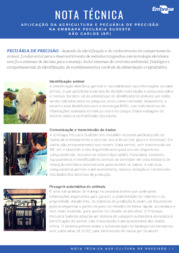Uruguayan researchers learn about field precision instruments
Uruguayan researchers learn about field precision instruments
The Uruguayan researchers Agustín Giménez and Sebastián Oviedo, from INIA (Instituto Nacional de Investigación Agropecuaria), visited three Embrapa research centers this week. They arrived in the country on Monday, May 6, and will return to Uruguay this Friday, 10. The scientists are insterested in precision agriculture and cattle farming, and in ICLFS (Integrated Crop-Livestock-Forestry Systems). Giménez researches climate and information systems. Oviedo works in international cooperation and strategic intelligence.
The visit started at Embrapa Agricultural Informatics, in Campinas, SP, on Tuesday (7). At that research center, they discussed potential cooperation in topics related to digital agriculture and strategic intelligence. They explained that INIA has an interest in working with more focus and integration on information and communication technologies (ICTs) applied to agriculture, to structure a vision for the future at institution level.
According to Giménez, just like Embrapa, INIA produces a large quantity of qualified information about agriculture. “The challenge today is making such information accessible in systems that offer objective answers to users, e.g. the best varieties, seasons for sowing, fertilization, among other themes”. He underscored that the development of tools to support decision-making (remote property management) and of technologies like natural language processing for applications in advanced search engines.
São Carlos
On Wednesday (8), Giménez and Oviedo visited Embrapa Southeast Livestock (São Carlos, SP), where they saw ICLFS. Giménez stated that crop rotation is common in Uruguay, but farmers are more interested in growing soybeans due to its profitability. Integration with forests drew attention among the researchers, who enquired about planted species and timber uses.
The researcher and the internacional liaison officer in the research center, Alberto Bernardi, showed the visitors the tools used in the field to collect data – animal necklaces with sensors, antennae by the troughs to capture signal, and solar panels to maintain the system. They could also see equipment that automates the feeding of confined animals (Grow Safe) and that measure emissions from the animals during the feeding (GreenFeed).
Both got to know the Canchim cattle breed, developed by Embrapa Southeast Livestock, and their milk production system. At INIA, the researchers have been using a robot-led milking system for two years; in that country, the breed that is most spread is the English Hereford, they said.
On Thursday (9), Giménez and Oviedo visited Lanapre (Precision Agriculture Laboratory), the National Laboratory on Nanotechnology for Agribusiness (LNNA), the Optics and Photonics Lab and the Nuclear Techniques Lab, after being welcomed by Embrapa Instrumentation's executives and researchers.
Translation: Mariana Medeiros
Ana Maio (Mtb 21.928)
Embrapa Southeast Livestock
Press inquiries
pecuaria-sudeste.imprensa@embrapa.br
Phone number: +55 16 3411-5734
Graziella Galinari (MTb 3863/PR)
Embrapa Agricultural Informatics
Press inquiries
informatica-agropecuaria.imprensa@embrapa.br
Phone number: +55 19 3211-5806
Joana Silva (MTb 19.554/SP)
Embrapa Instrumentation
Press inquiries
instrumentacao.imprensa@embrapa.br
Phone number: +55 16 2107 2901
Further information on the topic
Citizen Attention Service (SAC)
www.embrapa.br/contact-us/sac/


